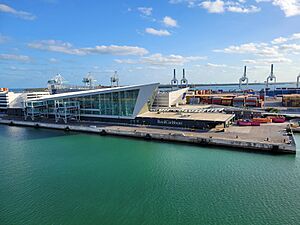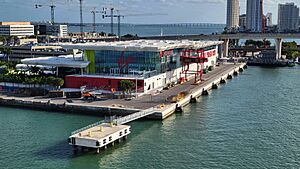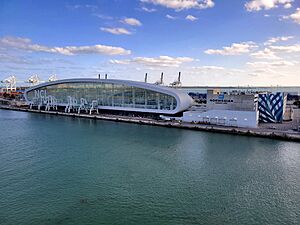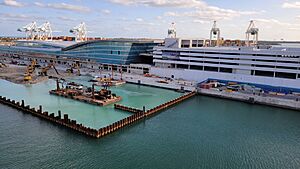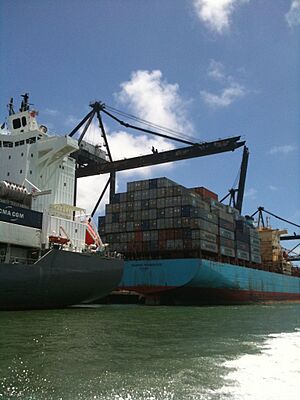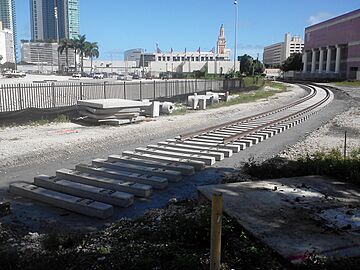PortMiami facts for kids
Quick facts for kids PortMiami |
|
|---|---|
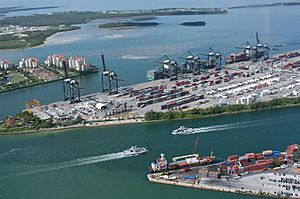 |
|
| Lua error in Module:Location_map at line 530: Unable to find the specified location map definition: "Module:Location map/data/yes" does not exist. | |
| Location | |
| Country | United States |
| Location | Miami, Florida, U.S. |
| Coordinates | 25°46′27″N 80°10′16″W / 25.77417°N 80.17111°W |
| Details | |
| Type of harbor | Natural/Artificial |
| Draft depth | 43 ft. |
| Employees | 176,000 |
| Port Director | Juan Kuryla |
| Statistics | |
| Vessel arrivals | 2,489 |
| Annual cargo tonnage | 7.42 million |
| Passenger traffic | 4.33 million |
| Annual revenue | $94.70 million |
| Formerly | Port of Miami |
| Website PortMiami |
|
PortMiami is a huge seaport in Miami, Florida. It sits in Biscayne Bay where the Miami River meets the ocean. This port is known as the world's largest port for cruise ships. It is also one of the biggest ports in the United States for cargo (goods shipped in containers).
The port is built on three islands: Dodge, Lummus, and Sam's Islands. These islands were joined together to create the large area for the port. It connects to Downtown Miami by a special road called Port Boulevard. There is also the PortMiami Tunnel that links it to Watson Island. The port is named after Dante Fascell, a Florida Congressman who served for many years.
As of 2023, PortMiami helps create about 334,500 jobs. It also brings in around $43 billion each year for the state of Florida. This shows how important the port is to the economy.
Contents
PortMiami's History and Growth
In the early 1900s, a new channel called Government Cut was dug. This channel made it much easier for ships to reach the port. The dirt dug out from this project created new islands. These islands later became Dodge, Lummus, and Sam's Islands.
As shipping grew, the port needed to expand. In 1960, officials decided to build a modern seaport on Dodge Island. This project involved joining Dodge Island with the other nearby islands. They built seawalls, office buildings, and bridges for cars and trains.
Once the new facilities were ready, all port operations moved to the larger Dodge Island. More land was added to Lummus and Sam's islands, creating one big artificial island for PortMiami. The port was officially named after Dante Fascell, a U.S. Representative from Florida.
Over the years, the port has continued to grow. In 1993, the port was deepened to 42 feet. This allowed bigger ships to enter. In 2006, a $40 million project expanded the South Harbor. A new project started in 2011 to reconnect the port to the mainland by railroad. In 2013, another project began to deepen the harbors even more, from 44 to 52 feet.
In 2019, Royal Caribbean Cruises got approval to build a new office and parking garage on Dodge Island. This shows the port is still expanding and attracting major companies.
PortMiami Today: Cruise and Cargo Operations
PortMiami is a very busy place! It handles millions of passengers and tons of cargo every year.
Cruise Ship Operations
PortMiami is the busiest cruise port in the world. Many major cruise lines use this port. These include Carnival, Royal Caribbean, Norwegian, Disney, and MSC. It is also the homeport for Symphony of the Seas, one of the largest cruise ships in the world. Over 5.5 million cruise passengers pass through the port each year.
As of July 2020, PortMiami has seven passenger terminals. These are named A, C, D, E, F, G, and J. Some terminals are built for specific cruise companies. Other companies share the remaining terminals. Five more company-specific terminals are being planned or built.
Current Passenger Terminals
| Terminal | Who Uses It |
|---|---|
| A | This terminal is only for cruise lines that are part of Royal Caribbean Group. It handles the world's largest cruise ships, like the Icon-class ships. |
| C | This terminal is mainly used by cruise lines that are part of Norwegian Cruise Line Holdings. |
| D | This terminal is mainly used by cruise lines that are part of Carnival Corporation & plc. |
| E | This terminal is mainly used by cruise lines that are part of Carnival Corporation & plc. |
| F | This terminal is mainly used by MSC Cruises. |
| G | This terminal is mainly used by cruise lines that are part of Royal Caribbean Group. |
| J | This is PortMiami's special terminal for smaller, luxury cruise ships. It serves lines like Oceania Cruises and Regent Seven Seas Cruises. |
| V | This terminal is mainly used by Virgin Voyages. |
Future Terminals and Projects
In 2018, Norwegian Cruise Line Holdings announced plans for a new 166,000 square foot facility. This new "Terminal B" is designed for Norwegian's largest ships. It opened in August 2021.
MSC Cruises also announced plans in 2018 to build "Terminal AA/AAA." This terminal will be for their huge new World|cruise ship|0 class ships. This is MSC's second big investment at PortMiami. The new $300 million building will have two berths, meaning two ships can dock at the same time. It is expected to be finished in October 2022.
Disney Cruise Line is also planning a new terminal, "Terminal K." This terminal will be on the south side of the port. It will allow Disney to have two ships based in Miami in the mid-2020s.
In 2018, Virgin Voyages announced plans for "Terminal V." This new 100,000 square foot terminal will be the homeport for their first two ships. It is located on the northwest side of the port. The terminal was scheduled to be completed by November 2021.
Carnival Cruise Line also got approval in 2019 to expand its facilities. They are renovating and expanding "Terminal F." This will be Carnival's largest terminal in North America. It is scheduled to open in October 2022.
Container Ship Operations
PortMiami is known as the "Cargo Gateway of the Americas." It mainly handles containerized cargo. This means goods packed into large metal boxes. It also handles some other types of cargo, like vehicles. It is the largest container port in Florida and the ninth largest in the United States.
Over 9.6 million tons of cargo move through the port each year. This includes over 1 million TEU (a measure for containers). Cargo operations at PortMiami bring $35 billion to Florida's economy.
In 2021, almost 1,000 cargo ships docked at the port. China is PortMiami's biggest trade partner for containers. Honduras is the top partner for trade value. Computers are the port's most valuable export. Insulated wire and cable are the most valuable import.
Port Design and Infrastructure
The port has eight passenger terminals and many facilities for cargo. These include six gantry crane wharves and seven Ro-Ro (Roll-on-Roll-off) docks. Ro-Ro docks allow vehicles to drive directly on and off ships. There are also refrigerated yards for containers and warehouses for other cargo.
To stay a top port, PortMiami started a $250 million improvement program in 1997. This program helps the port meet the needs of cruise lines and cargo shippers. The PortMiami Tunnel was built between 2010 and 2014. This tunnel connects the port directly to the interstate highway system. This helps reduce traffic in downtown Miami.
As part of the redevelopment, new cruise terminals and parking garages were built. A new gantry crane dock and container storage yards were also added. The port even got two huge new gantry cranes. These cranes are among the largest in the world. They can load and unload mega container ships that are almost 200 feet wide. This, along with the Deep Dredge Project, allows PortMiami to handle the largest container ships in the world.
Tunnel and Deep Dredge Projects
Two major projects have greatly improved PortMiami: the PortMiami Tunnel and the PortMiami Deep Dredge Project. These projects help the port handle more ships and cargo.
Construction on the Miami Port Tunnel began in 2010. This $1 billion project created a direct link from the port to I-395. Before the tunnel, all port traffic had to go through downtown Miami. The tunnel was completed in 2014.
The PortMiami Deep Dredge project made the port deeper. This allows very large ships, called Super Post Panamax Megaships, to enter the port. These ships can now come to the U.S. after the Panama Canal was expanded in 2014. This project is expected to double Miami's cargo business. It could also create over 30,000 permanent jobs for Miami.
There were also plans to build a soccer-specific stadium at PortMiami. A group led by David Beckham proposed this idea. They wanted to bring a Major League Soccer team to Miami. However, there was opposition due to concerns about traffic and wildlife.
Railroad Access for Cargo
In 2011, PortMiami received a special grant. This money was used to fix a railroad connection. The connection links the port to the Florida East Coast Railway's yard in Hialeah. This means the port is now directly connected to rail networks across the country. It also brought back the port's ability to load and unload cargo directly between ships and trains.
The railroad bridge connecting the port to the mainland was damaged by Hurricane Wilma in 2005. Train service was stopped then. The repair project was planned to finish by 2014. This rail project is part of a bigger plan to increase PortMiami's capacity. An inland center for cargo, called Flagler Logistics Hub, is also being built near the airport.
Some people were worried about the railroad line returning. They thought it would cause traffic and noise. However, trains will only run occasionally. They will be used for special cargo like very large items or dangerous materials. These items are not allowed in the tunnel. Also, the trains can now travel faster, crossing busy roads quickly.
The cost to fix the rail link was about $46.9 million. A federal grant provided $22 million for this project. This also included building a rail yard at the port. The project was expected to remove 5% of the road traffic from the port. It was also expected to create over 800 jobs.
In 2019, Brightline announced plans to build a train station at PortMiami. This could bring passenger train service to the port in the future.
See also
 In Spanish: PortMiami para niños
In Spanish: PortMiami para niños


